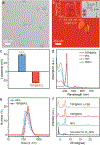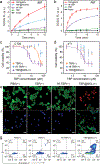2D Nano-Sonosensitizers Facilitate Energy Transfer to Enhance Sonodynamic Therapy
- PMID: 36840977
- PMCID: PMC10175216
- DOI: 10.1002/adma.202212069
2D Nano-Sonosensitizers Facilitate Energy Transfer to Enhance Sonodynamic Therapy
Abstract
Although sonodynamic therapy (SDT) has shown promise for cancer treatment, the lack of efficient sonosensitizers (SSs) has limited the clinical application of SDT. Here, a new strategy is reported for designing efficient nano-sonosensitizers based on 2D nanoscale metal-organic layers (MOLs). Composed of Hf-oxo secondary building units (SBUs) and iridium-based linkers, the MOL is anchored with 5,10,15,20-tetra(p-benzoato)porphyrin (TBP) sensitizers on the SBUs to afford TBP@MOL. TBP@MOL shows 14.1- and 7.4-fold higher singlet oxygen (1 O2 ) generation than free TBP ligands and Hf-TBP, a 3D nanoscale metal-organic framework, respectively. The 1 O2 generation of TBP@MOL is enhanced by isolating TBP SSs on the SBUs of the MOL, which prevents aggregation-induced quenching of the excited sensitizers, and by triplet-triplet Dexter energy transfer between excited iridium-based linkers and TBP SSs, which more efficiently harnesses broad-spectrum sonoluminescence. Anchoring TBP on the MOL surface also enhances the energy transfer between the excited sensitizer and ground-state triplet oxygen to increase 1 O2 generation efficacy. In mouse models of colorectal and breast cancer, TBP@MOL demonstrates significantly higher SDT efficacy than Hf-TBP and TBP. This work uncovers a new strategy to design effective nano-sonosensitizers by facilitating energy transfer to efficiently capture broad-spectrum sonoluminescence and enhance 1 O2 generation.
Keywords: energy transfer; metal-organic layers; nanoparticles; sonodynamic therapy; sonosensitizers.
© 2023 The Authors. Advanced Materials published by Wiley-VCH GmbH.
Conflict of interest statement
Conflicts of Interest
The authors declare no competing interests.
Figures





Similar articles
-
Porphyrin-based nanoscale metal-organic framework nanocarriers entrapping platinum nanoparticles and S-nitrosoglutathione for sonodynamic therapy in hypoxic tumors.Biomater Sci. 2025 Jun 10;13(12):3325-3335. doi: 10.1039/d5bm00127g. Biomater Sci. 2025. PMID: 40327017
-
Recent Developments of Inorganic Nanosensitizers for Sonodynamic Therapy.Adv Healthc Mater. 2023 Sep;12(22):e2300234. doi: 10.1002/adhm.202300234. Epub 2023 May 1. Adv Healthc Mater. 2023. PMID: 37070721 Review.
-
Titanium-Based Nanoscale Metal-Organic Framework for Type I Photodynamic Therapy.J Am Chem Soc. 2019 Mar 13;141(10):4204-4208. doi: 10.1021/jacs.8b13804. Epub 2019 Feb 26. J Am Chem Soc. 2019. PMID: 30779556
-
Water-Soluble Iridic-Porphyrin Complex for Non-invasive Sonodynamic and Sono-oxidation Therapy of Deep Tumors.ACS Appl Mater Interfaces. 2021 Jun 23;13(24):27934-27944. doi: 10.1021/acsami.1c06381. Epub 2021 Jun 8. ACS Appl Mater Interfaces. 2021. PMID: 34101408
-
Organic Sonosensitizers for Sonodynamic Therapy: From Small Molecules and Nanoparticles toward Clinical Development.Small. 2021 Oct;17(42):e2101976. doi: 10.1002/smll.202101976. Epub 2021 Aug 4. Small. 2021. PMID: 34350690 Review.
Cited by
-
Recent Advances of Emerging Metal-Containing Two-Dimensional Nanomaterials in Tumor Theranostics.Int J Nanomedicine. 2024 Jan 24;19:805-824. doi: 10.2147/IJN.S444471. eCollection 2024. Int J Nanomedicine. 2024. PMID: 38283201 Free PMC article. Review.
-
Applications of sonodynamic therapy combined with nanobiotechnology in the treatment of digestive tract tumors.Discov Oncol. 2025 Jul 1;16(1):1238. doi: 10.1007/s12672-025-02810-x. Discov Oncol. 2025. PMID: 40591113 Free PMC article. Review.
-
Drug repurposing: isosorbide mononitrate enhances tumor accumulation to augment sonodynamic therapy for hepatocellular carcinoma.J Nanobiotechnology. 2025 Aug 25;23(1):587. doi: 10.1186/s12951-025-03674-7. J Nanobiotechnology. 2025. PMID: 40855307 Free PMC article.
-
Nanosensitizer-assisted sonodynamic therapy for breast cancer.J Nanobiotechnology. 2025 Apr 7;23(1):281. doi: 10.1186/s12951-025-03311-3. J Nanobiotechnology. 2025. PMID: 40197318 Free PMC article. Review.
-
Microenvironment Restruction of Emerging 2D Materials and their Roles in Therapeutic and Diagnostic Nano-Bio-Platforms.Adv Sci (Weinh). 2023 Jul;10(20):e2207759. doi: 10.1002/advs.202207759. Epub 2023 May 2. Adv Sci (Weinh). 2023. PMID: 37129318 Free PMC article. Review.
References
-
- Brotchie A, Nature Reviews Materials 2017, 2, 17058.
-
- Choi V, Rajora MA, Zheng G, Bioconjugate Chemistry 2020, 31, 967. - PubMed
-
- Stride E, Coussios C, Nature Reviews Physics 2019, 1, 495.
-
- Son S, Kim JH, Wang X, Zhang C, Yoon SA, Shin J, Sharma A, Lee MH, Cheng L, Wu J, Kim JS, Chemical Society Reviews 2020, 49, 3244. - PubMed
-
- Qian X, Zheng Y, Chen Y, Advanced Materials 2016, 28, 8097. - PubMed
MeSH terms
Substances
Grants and funding
LinkOut - more resources
Full Text Sources
Medical
Research Materials
Miscellaneous

